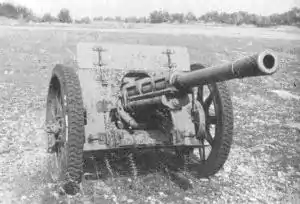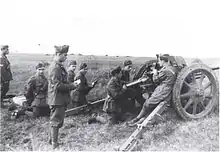Cannone da 75/32 modello 37
The Cannone da 75/32 modello 37 was an Italian field gun used during World War II. The designation indicates that the gun had a 75 mm caliber, the barrel was 32 caliber-lengths long and it was accepted for service in 1937.
| Cannone da 75/32 modello 37 | |
|---|---|
 | |
| Type | Field gun |
| Place of origin | Italy |
| Service history | |
| Used by | Italy Nazi Germany Peru |
| Wars | Second World War,Ecuadorian–Peruvian War |
| Production history | |
| Designer | Ansaldo |
| Specifications | |
| Mass | Travel: 1,250 kg (2,760 lb) Combat: 1,200 kg (2,600 lb) |
| Shell weight | 6.3 kg (14 lb) |
| Caliber | 75 mm (3.0 in) |
| Carriage | Split-trail |
| Elevation | −10° to +45° |
| Traverse | 50° |
| Muzzle velocity | 624 m/s (2,050 ft/s) |
| Maximum firing range | 12.5 km (13,700 yd)[1] |
History

The Cannone da 75/32 was designed by Ansaldo and the first examples were produced in 1937.
After Italy surrendered, guns captured by Germany were designated 7.5 cm FK248(i).
This gun was used in Russia with the ARMIR (ARMata Italiana in Russia - Italian Army in Russia) in the "201º Reggimento d'artiglieria motorizzato" and it had good results against the Soviet T-34 tank.
Some were acquired by the Peruvian Army before the Ecuadorian–Peruvian War of 1941.[2]
Technicalities
The barrel was one piece and in the prototype it was equipped with a muzzle brake. The rifling had a step of 20 calibers.
The mount,similar to that of the 75/18 Mod. 1934/1935,had metal spoked wheels,originally in Elektron,an alloy of Magnesium and Aluminium,then later it got replaced by sheet steel. The wheels had a diameter of 1,3 meters (3,28 ft) with a semi-pneumatic ring,and an elastic torsion bar suspension. The maximum towing velocity for this piece was 60km/h (37,2 mph),superior to the one normally used for light artillery. The split-tails could fold in two elements,obtaining a length gear configuration that was quite limited.
The piece was able to shoot both a projected foil on two charges (so on two different muzzle velocities) and a projected foil in one charge.from 1943 onwards it was provided with a 12 mm thick shield and a faster loading system to allow an easier engagement with armored vehicles.
References
- Chamberlain, Peter (1975). Light and medium field artillery. Gander, Terry. New York: Arco. p. 36. ISBN 0668038209. OCLC 2067331.
- Jowett, Philip (28 Jun 2018). Latin American Wars 1900–1941: "Banana Wars," Border Wars & Revolutions. Men-at-Arms 519. Osprey Publishing. p. 40. ISBN 9781472826282.
- Artillery by Chris Chant, published by Amber Books, ISBN 1-84509-248-1